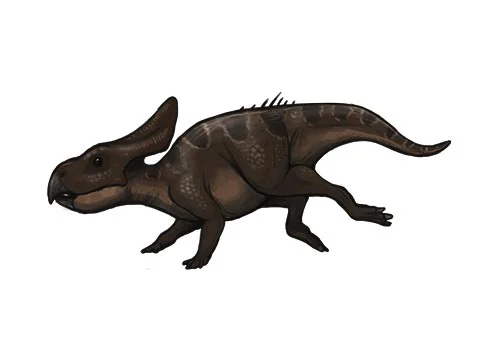Protoceratops (First horned face)

Pro-toe-seh-rah-tops
Walter W. Granger & William King Gregory - 1923
Herbivore
Estimated 2 meters long
P. andrewsi (type), P. hellenikorhinus
A. oshimai (type), A. yujingziensis
China. Mongolia
Late Cretaceous, 80-75 million years ago
Protoceratops Facts
Protoceratops, meaning “first horned face,” is a genus of herbivorous dinosaur that lived during the Late Cretaceous period, approximately 80 to 75 million years ago. It was a member of the group known as ceratopsians, which were characterized by their large, bony frills and horns on their faces.
Protoceratops was first discovered during the 1920s and 1930s by expeditions to Mongolia led by Roy Chapman Andrews and Walter Granger of the American Museum of Natural History. Since then, many fossils of Protoceratops have been found in the Gobi Desert region, providing important insights into the diversity and evolution of ceratopsian dinosaurs.
Protoceratops was a small to medium-sized dinosaur, measuring up to 2 meters (6.5 feet) in length and weighing up to 180 kilograms (400 pounds). It had a relatively short, bulky body with four sturdy legs and a long tail. Its most distinctive features were the large frill on its head and the beak-like structure at the front of its jaws.
The frill of Protoceratops was large and relatively flat, with a rough, bumpy texture that may have provided a surface for muscle attachment. Some specimens also had small horns on the top of their frills, although these were much smaller than the large horns of later ceratopsians such as Triceratops.
Protoceratops likely fed on a variety of vegetation, including ferns, cycads, and flowering plants. Its powerful jaws and hundreds of closely packed teeth would have allowed it to grind tough plant material efficiently.
One of the most famous fossils of Protoceratops is a pair of specimens that were found in close association, seemingly locked in combat. This has led to speculation that Protoceratops engaged in intraspecific combat, using their frills and horns as weapons to defend their territories or compete for mates.
As a paleontologist, studying fossils of Protoceratops and other ceratopsian dinosaurs helps us to better understand the diversity and evolution of this group of dinosaurs, and their place in the ecosystem of the Late Cretaceous period. It also provides important insights into the evolution of elaborate head and neck structures in dinosaurs, and the function of these structures in behavior and ecology.



